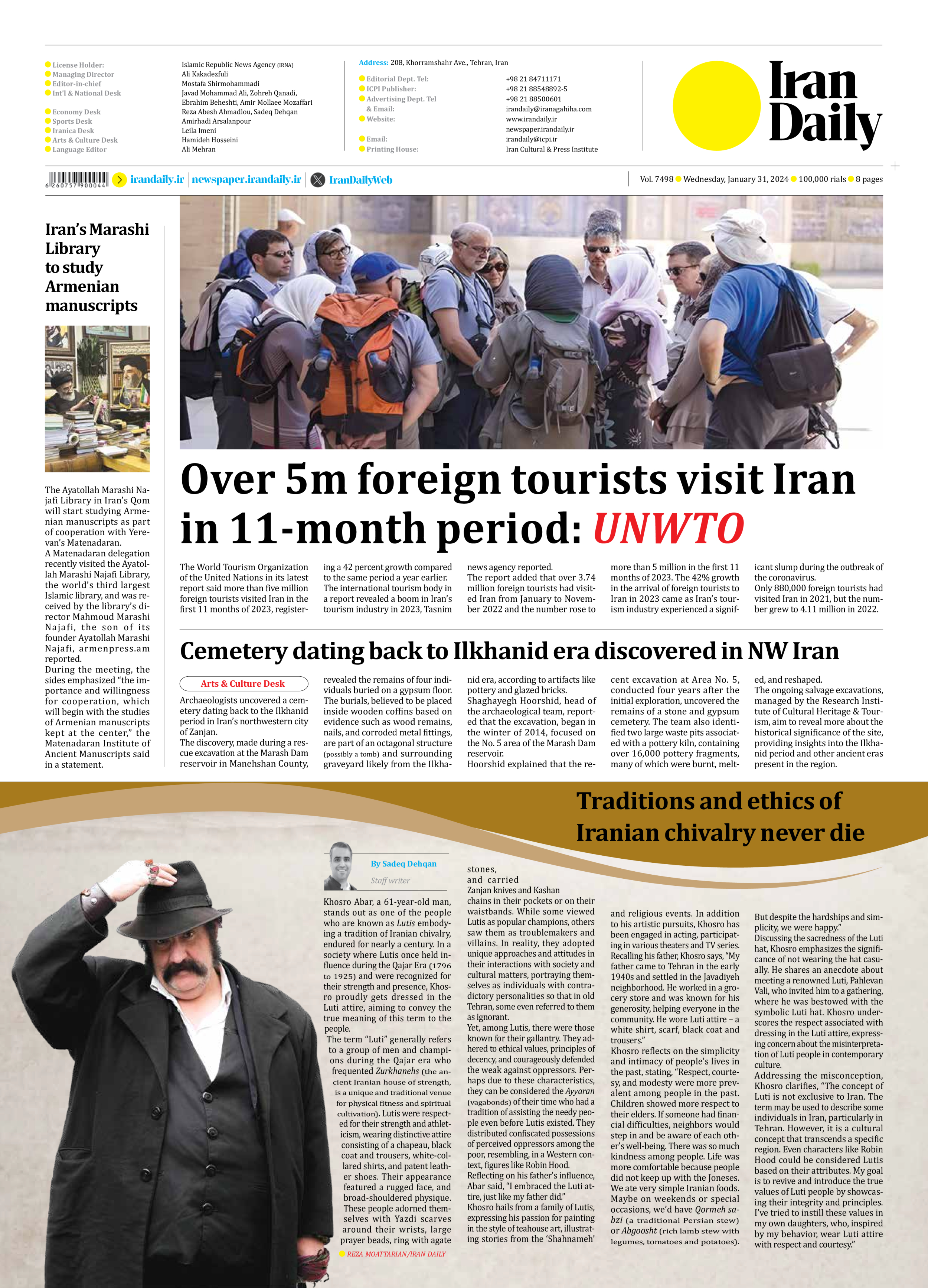
Traditions and ethics of Iranian chivalry never die
By Sadeq Dehqan
Staff writer
Khosro Abar, a 61-year-old man, stands out as one of the people who are known as Lutis embodying a tradition of Iranian chivalry, endured for nearly a century. In a society where Lutis once held influence during the Qajar Era (1796 to 1925) and were recognized for their strength and presence, Khosro proudly gets dressed in the Luti attire, aiming to convey the true meaning of this term to the
people.
The term “Luti” generally refers to a group of men and champions during the Qajar era who frequented Zurkhanehs (the ancient Iranian house of strength, is a unique and traditional venue for physical fitness and spiritual cultivation). Lutis were respected for their strength and athleticism, wearing distinctive attire consisting of a chapeau, black coat and trousers, white-collared shirts, and patent leather shoes. Their appearance featured a rugged face, and broad-shouldered physique. These people adorned themselves with Yazdi scarves around their wrists, large prayer beads, ring with agate stones, and carried Zanjan knives and Kashan chains in their pockets or on their waistbands. While some viewed Lutis as popular champions, others saw them as troublemakers and villains. In reality, they adopted unique approaches and attitudes in their interactions with society and cultural matters, portraying themselves as individuals with contradictory personalities so that in old Tehran, some even referred to them as ignorant.
Yet, among Lutis, there were those known for their gallantry. They adhered to ethical values, principles of decency, and courageously defended the weak against oppressors. Perhaps due to these characteristics, they can be considered the Ayyaran (vagabonds) of their time who had a tradition of assisting the needy people even before Lutis existed. They distributed confiscated possessions of perceived oppressors among the poor, resembling, in a Western context, figures like Robin Hood.
Reflecting on his father’s influence, Abar said, “I embraced the Luti attire, just like my father did.”
Khosro hails from a family of Lutis, expressing his passion for painting in the style of teahouse art, illustrating stories from the ‘Shahnameh’ and religious events. In addition to his artistic pursuits, Khosro has been engaged in acting, participating in various theaters and TV series.
Recalling his father, Khosro says, “My father came to Tehran in the early 1940s and settled in the Javadiyeh neighborhood. He worked in a grocery store and was known for his generosity, helping everyone in the community. He wore Luti attire – a white shirt, scarf, black coat and trousers.”
Khosro reflects on the simplicity and intimacy of people’s lives in the past, stating, “Respect, courtesy, and modesty were more prevalent among people in the past. Children showed more respect to their elders. If someone had financial difficulties, neighbors would step in and be aware of each other’s well-being. There was so much kindness among people. Life was more comfortable because people did not keep up with the Joneses. We ate very simple Iranian foods. Maybe on weekends or special occasions, we’d have Qormeh sabzi (a traditional Persian stew) or Abgoosht (rich lamb stew with legumes, tomatoes and potatoes). But despite the hardships and simplicity, we were happy.”
Discussing the sacredness of the Luti hat, Khosro emphasizes the significance of not wearing the hat casually. He shares an anecdote about meeting a renowned Luti, Pahlevan Vali, who invited him to a gathering, where he was bestowed with the symbolic Luti hat. Khosro underscores the respect associated with dressing in the Luti attire, expressing concern about the misinterpretation of Luti people in contemporary culture.
Addressing the misconception, Khosro clarifies, “The concept of Luti is not exclusive to Iran. The term may be used to describe some individuals in Iran, particularly in Tehran. However, it is a cultural concept that transcends a specific region. Even characters like Robin Hood could be considered Lutis based on their attributes. My goal is to revive and introduce the true values of Luti people by showcasing their integrity and principles. I’ve tried to instill these values in my own daughters, who, inspired by my behavior, wear Luti attire with respect and courtesy.”







